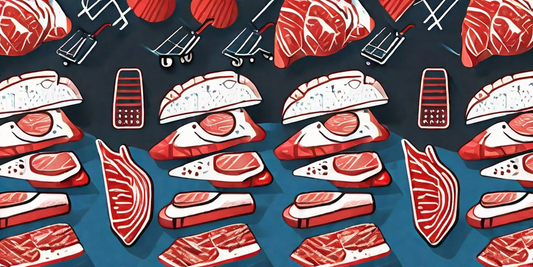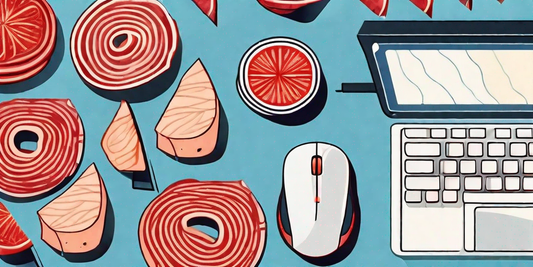Cheddar cheese is a beloved, versatile cheese that comes in various forms. One form that stands out for its rich flavor and unique texture is aged sharp cheddar cheese. Understanding the aging process of cheddar cheese is crucial to appreciating the distinct characteristics that make aged sharp cheddar cheese a favorite among cheese connoisseurs.
Understanding the Aging Process of Cheddar Cheese
Cheddar cheese undergoes a complex aging process that significantly impacts its flavor, texture, and overall quality. The science behind aging cheese involves a series of biochemical and enzymatic reactions that occur within the cheese as it matures.
The aging process begins immediately after the cheese is made. During this time, the cheese is stored in a controlled environment with regulated temperature and humidity. These conditions allow the flavors of the cheese to develop and intensify over time.
One fascinating aspect of the aging process is the role of enzymes. Enzymes naturally present in the cheese break down the proteins, releasing amino acids that contribute to the cheese's flavor. These amino acids add depth and complexity to the taste, creating a more enjoyable experience for cheese enthusiasts.
Additionally, the breakdown of fats leads to the formation of various flavorful compounds, such as fatty acids and esters. These compounds enhance the complexity and depth of the cheese's flavor profile. Imagine the burst of flavors that dance on your taste buds as you savor a piece of well-aged cheddar cheese.
But it's not just enzymes that play a part in the aging process. Beneficial bacteria and molds also have a role to play. As the cheese ages, these microorganisms flourish and contribute to the development of unique flavors and textures in aged sharp cheddar cheese. They add a touch of complexity and create a harmonious balance of flavors that make each bite a delightful experience.
The Science Behind Aging Cheese
Aging cheese is a biochemical process that involves the breakdown of proteins and fats, resulting in the formation of new compounds. The intricate dance of enzymes, bacteria, and molds creates a symphony of flavors that make aged cheddar cheese so special.
As the cheese ages, the breakdown of lactose occurs. Lactose is the naturally occurring sugar in milk, and its gradual reduction gives aged sharp cheddar cheese its characteristic tanginess. This transformation adds a delightful zing to the flavor profile, making it a favorite among cheese connoisseurs.
Furthermore, as the cheese ages, it develops complex flavor notes that go beyond tanginess. Nutty undertones, reminiscent of roasted nuts, add a delightful richness to the taste. Caramel notes bring a touch of sweetness, balancing out the tanginess and creating a harmonious flavor profile. And let's not forget the savory undertones that add depth and complexity, making each bite a journey of flavors.
As time passes, the flavors deepen and evolve, resulting in a rich and sophisticated taste that can only be achieved through the aging process. It's a testament to the art and science of cheese-making, where patience and precise conditions come together to create a culinary masterpiece.
How Aging Affects the Flavor Profile
Aging significantly influences the flavor profile of cheddar cheese. The transformation from a mild and creamy taste to a robust, tangy, and sharp flavor is a result of the aging process.
As the cheese matures, the flavors become more pronounced and complex. The gradual breakdown of lactose not only adds tanginess but also allows other flavors to shine. The nutty undertones become more prominent, providing a delightful contrast to the tanginess. The caramel notes deepen, creating a subtle sweetness that balances out the flavors. And the savory undertones become more pronounced, adding a savory depth that lingers on the palate.
Each bite of aged sharp cheddar cheese is a sensory experience, with layers of flavors that unfold and evolve. The complexity and depth of the flavor profile make it a versatile cheese that can be enjoyed on its own or used to elevate a variety of dishes.
So next time you savor a piece of aged cheddar cheese, take a moment to appreciate the intricate aging process that has transformed it into a culinary masterpiece. From the enzymes breaking down proteins and fats to the flourishing of beneficial bacteria and molds, every step contributes to the creation of a cheese that is truly exceptional.
The History of Sharp Cheddar Cheese
The origins of cheddar cheese can be traced back to the English countryside, where it was first produced centuries ago. Over time, cheddar cheese gained popularity and evolved into the sharp, flavorful cheese we know today.
Origins of Cheddar Cheese
The origins of cheddar cheese can be attributed to the town of Cheddar in Somerset, England. It is believed that the making of cheddar cheese dates back to the 12th century. The unique qualities of the local water and grazing lands played a crucial role in the development of Cheddar production.
Evolution of Sharp Cheddar Cheese
As cheddar cheese making spread throughout England, various regional variations emerged. One notable development was the production of sharp cheddar cheese, which involves a longer aging process than traditional cheddar cheese.
The extended aging period of sharp cheddar cheese allows for a more pronounced and robust flavor to develop. This makes it a preferred choice among cheese enthusiasts who appreciate its distinct taste and texture.
The Production Process of Sharp Cheddar Cheese
The production of sharp cheddar cheese involves a meticulous process that requires specific ingredients and careful steps to ensure its quality and flavor.
Ingredients Required for Sharp Cheddar Cheese
The key ingredients for making sharp cheddar cheese include high-quality milk, starter cultures, rennet, and salt. These ingredients play a vital role in shaping the cheese's texture and flavor.
Steps in Making Sharp Cheddar Cheese
The production of sharp cheddar cheese begins with pasteurizing the milk to ensure its safety and quality. Once the milk is heated and cooled, starter cultures and rennet are added to initiate the fermentation and coagulation processes.
After coagulation, the curds are cut, stirred, and heated to expel whey and promote the development of the cheese's unique texture. The curds are then pressed to remove excess moisture and achieve the desired firmness.
Following pressing, the cheese is salted, which enhances its flavor and acts as a preservative. The cheese is then aged for an extended period to develop its sharp taste and mature texture.
Nutritional Value of Aged Sharp Cheddar Cheese
Aged sharp cheddar cheese not only delights the taste buds but also offers several nutritional benefits. Understanding its nutritional value can help you make informed choices about incorporating it into your diet.
Health Benefits of Sharp Cheddar Cheese
Sharp cheddar cheese is a good source of protein and calcium, essential nutrients for building and maintaining strong bones and muscles. It also contains vitamins A, B12, and K2, which are important for various bodily functions, including vision, energy production, and blood clotting.
Additionally, aged sharp cheddar cheese is rich in conjugated linoleic acid (CLA), a fatty acid that has been associated with potential health benefits, such as improved heart health and reduced inflammation.
Nutritional Comparison with Other Cheeses
When comparing the nutritional value of aged sharp cheddar cheese with other cheeses, it is important to consider factors such as fat content and sodium levels. While aged sharp cheddar cheese may have a higher fat content, it is often lower in sodium compared to processed cheeses.
Furthermore, the aging process of sharp cheddar cheese enhances the availability of certain nutrients, such as calcium and CLA, making it a nutritious choice among cheese options.
Pairing and Serving Suggestions for Aged Sharp Cheddar Cheese
Aged sharp cheddar cheese can be enjoyed in various ways, whether on its own, paired with complementary flavors, or as a key ingredient in delectable recipes. Here are some creative pairing and serving suggestions to enhance your cheese indulgence.
Ideal Wine Pairings for Sharp Cheddar Cheese
When it comes to pairing aged sharp cheddar cheese with wine, the intensity of the cheese's flavors calls for wines that can stand up to its robustness. Rich red wines like Cabernet Sauvignon or Zinfandel pair well with the bold flavors of sharp cheddar cheese.
If you prefer white wine, opt for a full-bodied Chardonnay or a crisp Sauvignon Blanc to create a refreshing contrast to the cheese's sharpness.
Creative Recipes Featuring Aged Sharp Cheddar Cheese
Aged sharp cheddar cheese can elevate various recipes with its distinct flavor and meltability. Try incorporating it into classic dishes like mac and cheese, grilled cheese sandwiches, or cheese soufflés for a gourmet twist.
You can also experiment with unique combinations by adding aged sharp cheddar cheese to savory scones, stuffed mushrooms, or caramelized onion tarts for a burst of flavor.
Aged sharp cheddar cheese is a true testament to the art and science of cheese making. Its rich history, complex aging process, nutritional value, and versatility make it a coveted ingredient for cheese lovers and culinary enthusiasts alike. Whether enjoyed on its own, paired with wine, or used in creative recipes, aged sharp cheddar cheese never fails to leave a lasting impression.





